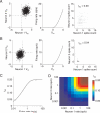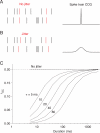Measuring and interpreting neuronal correlations
- PMID: 21709677
- PMCID: PMC3586814
- DOI: 10.1038/nn.2842
Measuring and interpreting neuronal correlations
Abstract
Mounting evidence suggests that understanding how the brain encodes information and performs computations will require studying the correlations between neurons. The recent advent of recording techniques such as multielectrode arrays and two-photon imaging has made it easier to measure correlations, opening the door for detailed exploration of their properties and contributions to cortical processing. However, studies have reported discrepant findings, providing a confusing picture. Here we briefly review these studies and conduct simulations to explore the influence of several experimental and physiological factors on correlation measurements. Differences in response strength, the time window over which spikes are counted, spike sorting conventions and internal states can all markedly affect measured correlations and systematically bias estimates. Given these complicating factors, we offer guidelines for interpreting correlation data and a discussion of how best to evaluate the effect of correlations on cortical processing.
Figures






References
-
- Tolhurst DJ, Movshon JA, Dean AF. The statistical reliability of signals in single neurons in cat and monkey visual cortex. Vision Res. 1983;23:775–785. - PubMed
-
- Abbott LF, Dayan P. The effect of correlated variability on the accuracy of a population code. Neural Comput. 1999;11:91–101. - PubMed
-
- Averbeck BB, Latham PE, Pouget A. Neural correlations, population coding and computation. Nat Rev Neurosci. 2006;7:358–366. - PubMed
Publication types
MeSH terms
Grants and funding
LinkOut - more resources
Full Text Sources
Other Literature Sources

